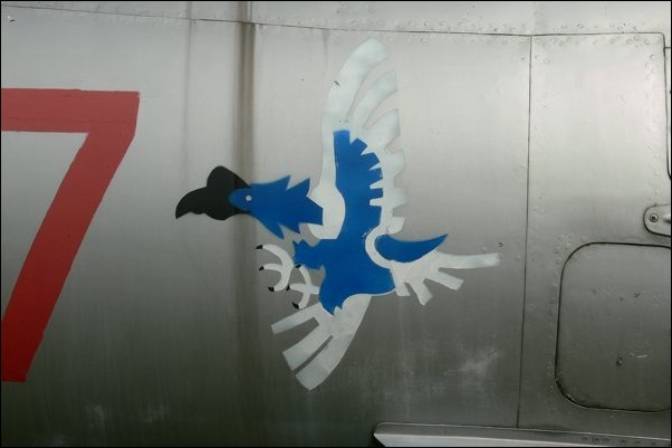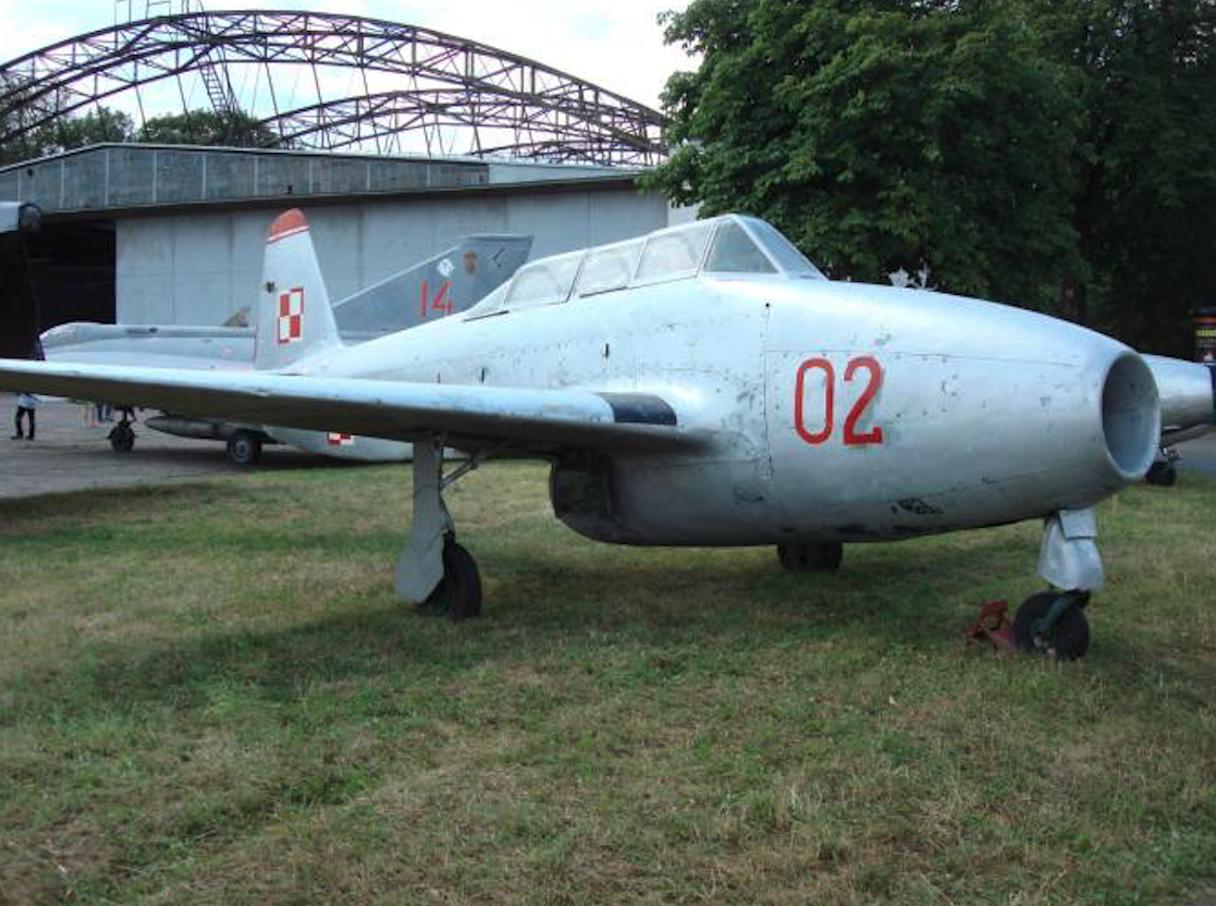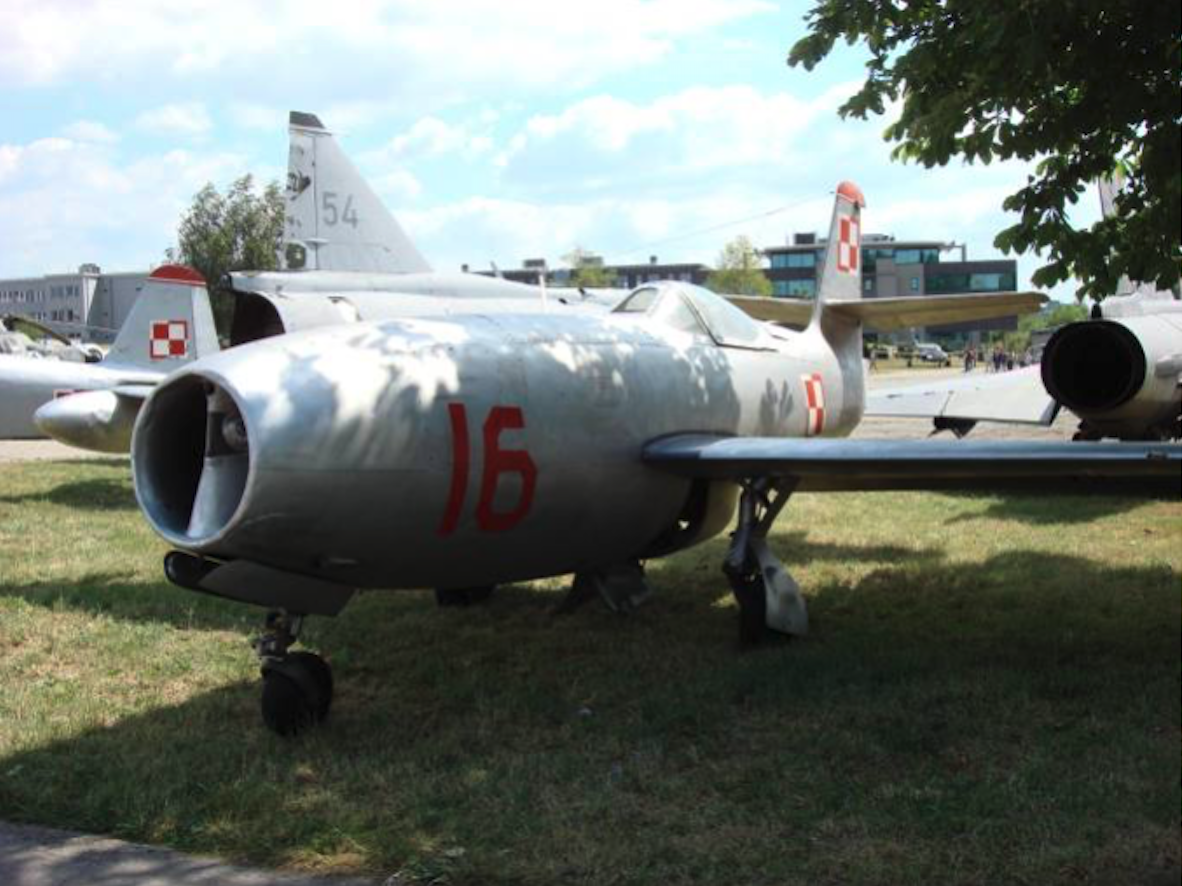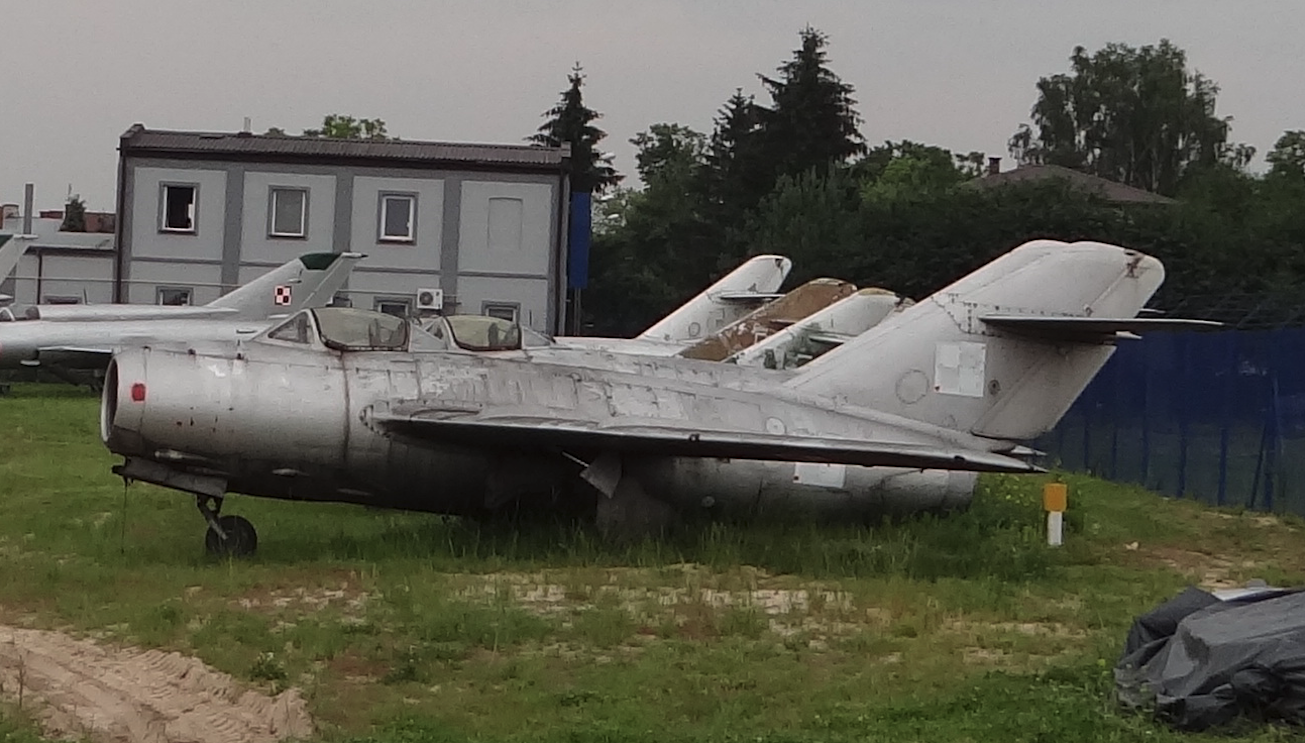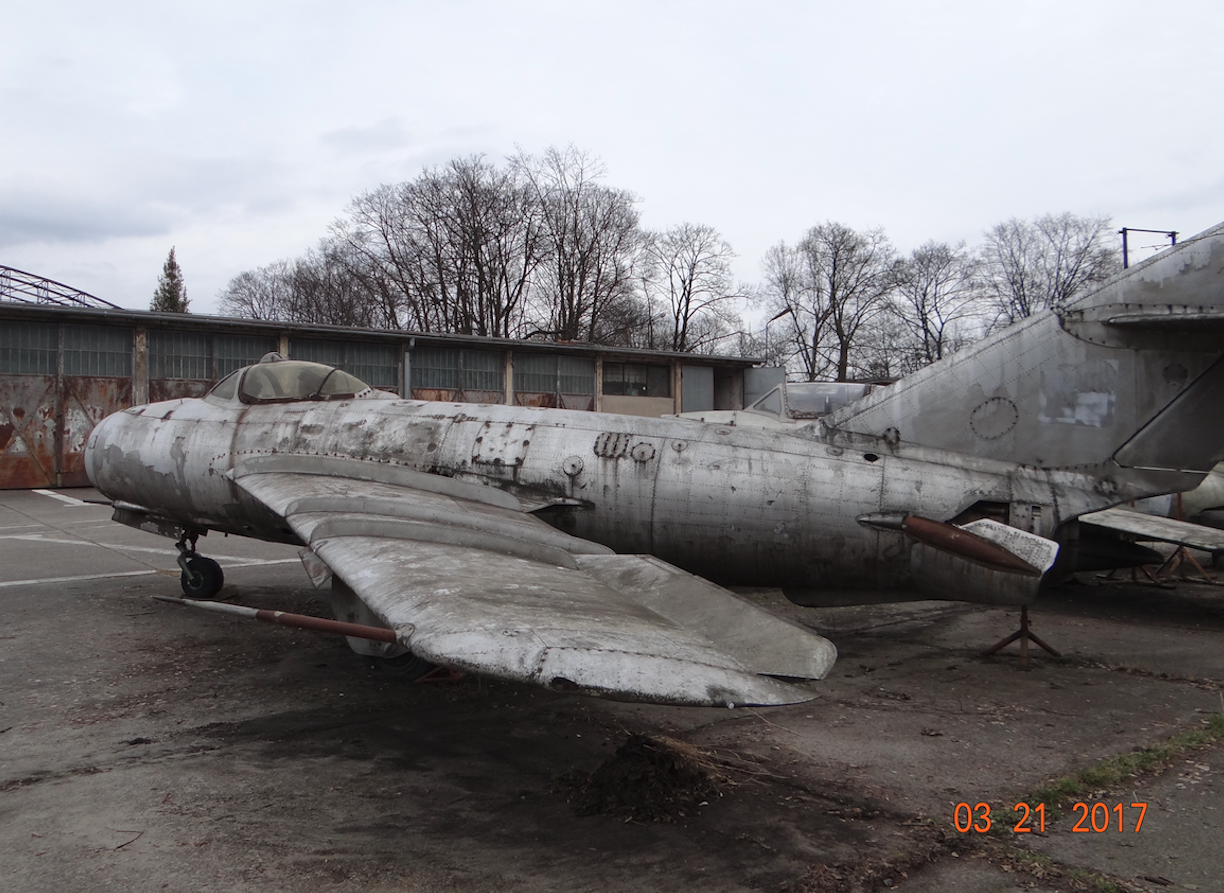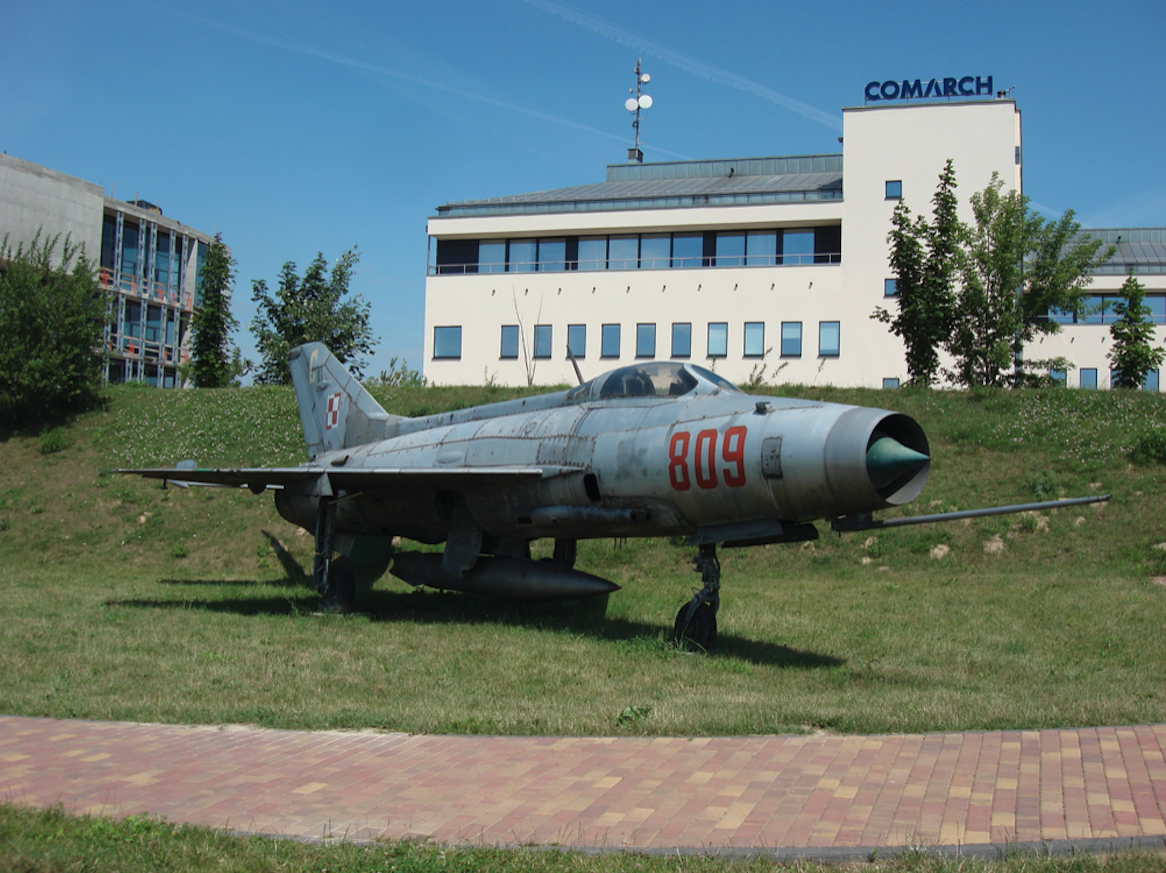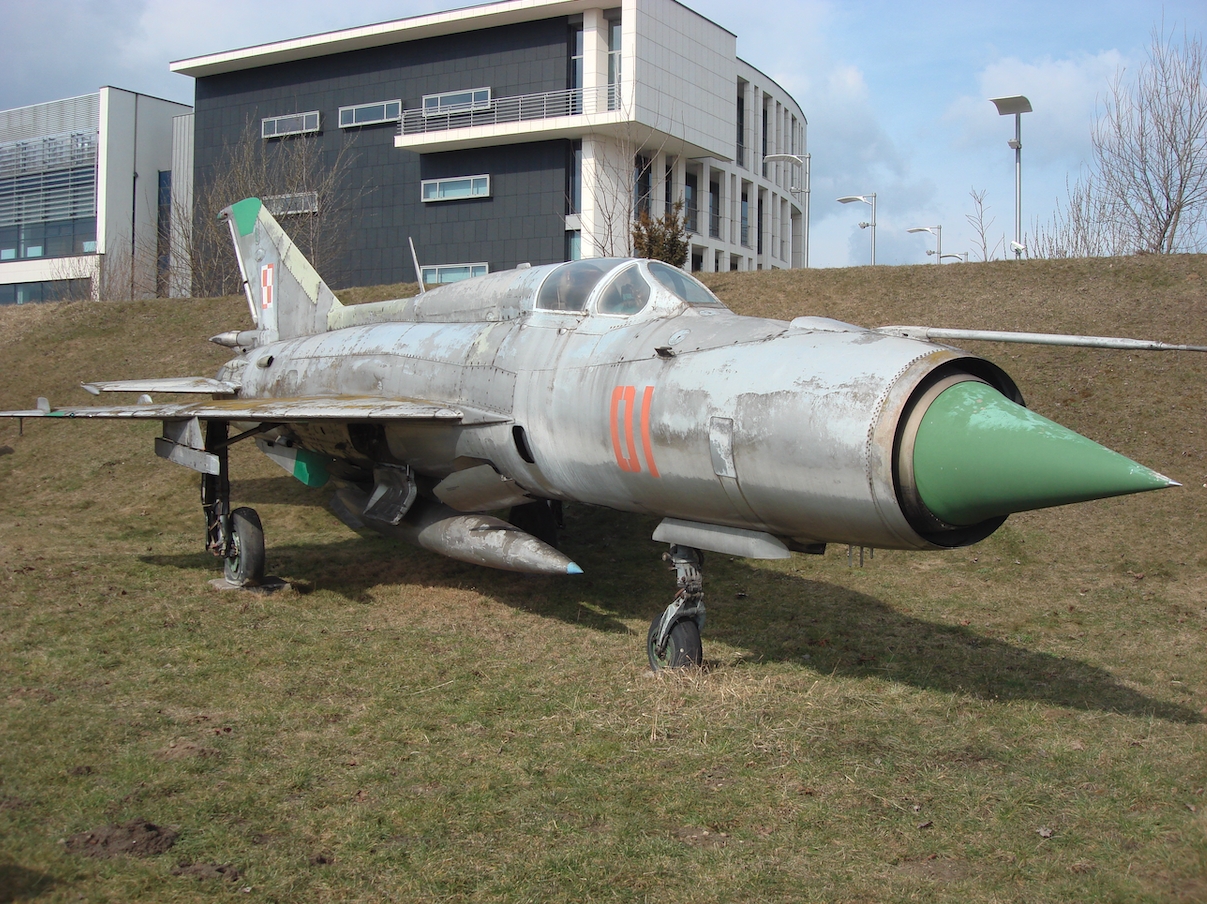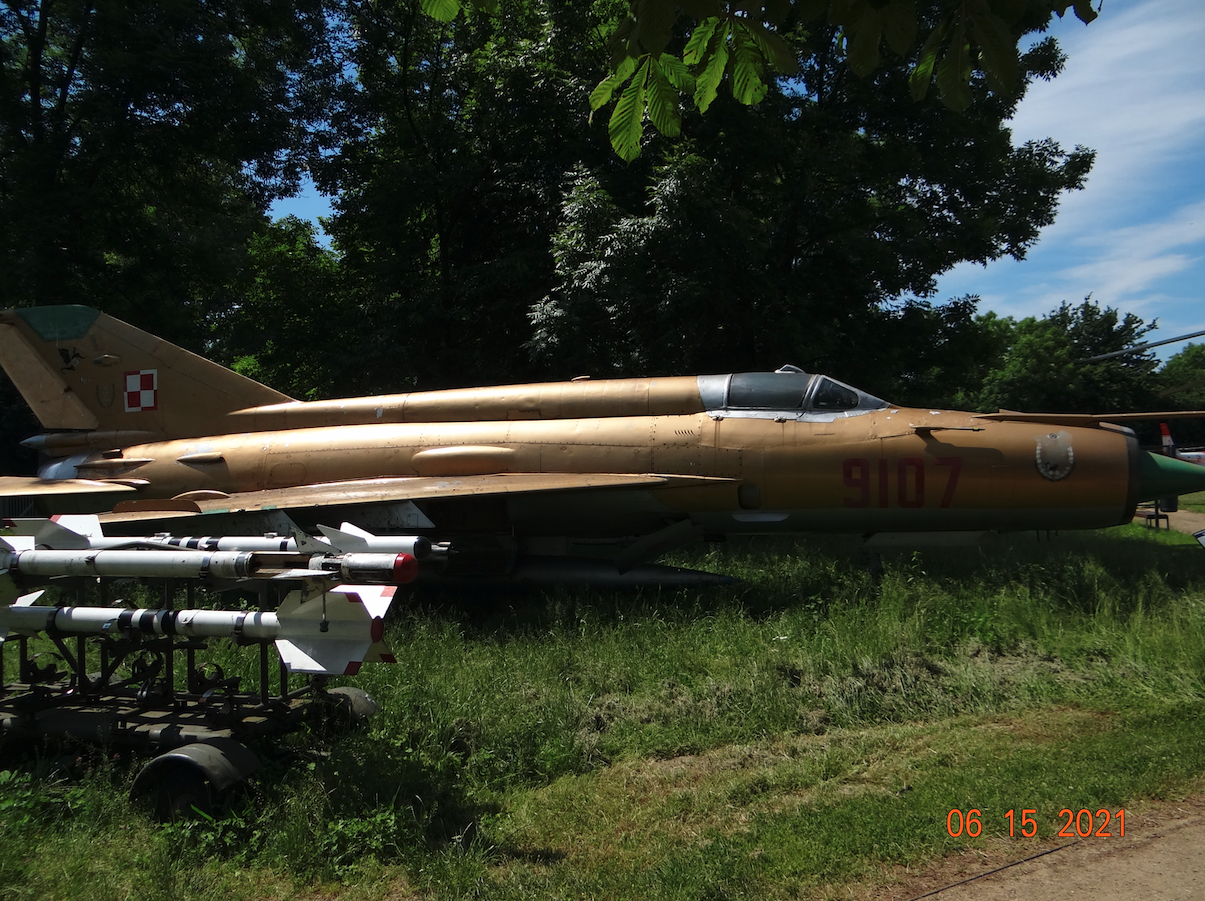Wrocław 2011-02-02
11 Myśliwski Pułk Lotniczy.
3 Pułk Lotnictwa Myśliwskiego.
11 Brandenburski Pułk Lotnictwa Myśliwskiego.
11 Pułk Lotnictwa Myśliwskiego im. Płk Bolesława Orlińskiego we Wrocławiu-Strachowicach.
1944r.-1999r.
Wstęp.
W planach sowieckich, w czasie drugiej wojny światowej, było utworzenie Polskiego związku lotniczego jako 3. Dywizji Lotnictwa Myśliwsko-Bombowego. Z powodu braku odpowiedniego sprzętu przystąpiono do formowania 3. Dywizji Lotnictwa Myśliwskiego w składzie trzech pułków myśliwskich, którym nadano oznaczenia: 9. PLM, 10. PLM, 11. PLM. Na marginesie w tym czasie pisano „myśliwski pułk lotniczy”, a nie „pułk lotnictwa myśliwskiego”. Podstawą był rozkaz operacyjny z dnia 7 września 1944 roku, w którym była mowa o powołaniu 1. Mieszanego Korpusu Lotniczego. Miejscem formowania była osada Karłówka na Ukrainie.
Każdy z pułków otrzymał następującą strukturę – dowództwo, sztab i trzy eskadry lotnicze. 11. PLM liczył około 200 żołnierzy i 35 samolotów typu Jak-1 / 3. Wszyscy dowódcy i piloci byli sowietami i pochodzili z innych sowieckich jednostek wojskowych. Tylko w personelu pomocniczym byli żołnierze narodowości Polskiej. Trzonem Pułku był 832. pułk sowiecki wycofany z linii frontu we wrześniu 1944 roku.
Od dnia 17 września 1944 roku, na lotnisku Krasnogród rozpoczęto szkolenie pilotów z 9. PLM, a na lotnisku Karłówka pilotów z 10. PLM i 11. PLM. Gotowość do rozpoczęcia działań wojennych osiągnięto z początkiem 1945 roku, choć faktycznie szkolenie trwało do marca 1945 roku. W dniu 20 stycznia 1945 roku, przystąpiono do przebazowania dywizji na teren Polski. Sowieci bardzo dbali o to, aby Polacy nie walczyli na terenach Wschodniej Rzeczpospolitej, na Polskich Kresach, a do walki przystąpili dopiero po przekroczenie linii rzeki Bug. Przebazowanie przeprowadzono w kilku rzutach powietrznych i kołowych, a zakończono w marcu 1945 roku. Pierwszym lotniskiem Pułku na terenie Polski stało się Lotnisko Ułęż na Lubelszczyźnie. Jeszcze wówczas Pułk nie wziął udziału w walkach. Front był daleko.
Przypuszczalnie w dniu 20 kwietnia 1945 roku, sowieci zdecydowali o udziale 11. PLM w operacji berlińskiej. W dniach 23-24 kwietnia 1945 roku, Pułk przebazowano na Lotnisko w Witnicy w rejonie Kostrzyna nad Odrą. W tym samym dniu (24 kwiecień 1945 rok) piloci wykonali pierwsze loty bojowe. Były to zadania osłony z powietrza działań 1. Armii Wojska Polskiego. Dzień ten stał się świętem dla jednostki.
Już od 27 kwietnia 1945 roku, loty bojowe Pułk wykonywał z Lotniska Strinbeck, na wschód od Berlina, a od dnia 1 maja 1945 roku, z Lotniska Eichstadt, na północ od Berlina. W tym czasie, główne zadania pułku to była; osłona natarć piechoty i czołgów, osłona szturmowych Ił-2, atak na cele naziemne i rozpoznanie.
11 PLM zakończył swój szlak bojowy już w dniu 3 maja 1945 roku, nad Łabą w Brandenburgii. Na 5 dni przed faktycznym końcem wojny, 11. Pułk otrzymał rozkaz powrotu do Polski. Były to działania sowieckie, w celu pokazania Polsce jej miejsca jako kraju zależnego od CCCP.
Ogółem piloci Pułku wykonali 329 lotów bojowych. Stoczyli 6 walk powietrznych, podczas których zestrzelili dwa samoloty germańskie. W dniu 2 maja 1945 roku, dwa samoloty Fieseler Fi 156 Storch. Czynu tego dokonał chorąży pilot Aleksander Krasucki ( sowiet ). Straty własne Pułku to dwóch pilotów; dowódca 1. eskadry kapitan pilot Szot Grdzeliszwili oraz chorąży Sławomir Skibina. Obaj pochowani zostali na cmentarzu w Kutnie. Za wysiłek bojowy dywizja otrzymała Krzyż Grunwaldu I klasy i tytuł Brandenburskiej.
W 11. Pułku użytkowano samoloty: Jak-1, Jak-3, Jak-9 M / T, Jak-7, Po-2, UT-2.
Dowódcy Pułku; ppłk pilot Wiktor Sokołow ( 21.10.1944r. – 18.02.1945r. ), kapitan pilot Siergiej Wołkow ( 18.02.1945r. – co najmniej do 1946r. ).
| Lotnisko | Od | Do |
|---|---|---|
| Karłówka (sowiety) | 21.10.1944r. | 24.03.1945r. |
| Ułęż | 24.03.1945r. | 27.03.1945r. |
| Łąck | 27.03.1945r. | 23.04.1945r. |
| Witnica | 23.04.1945r. | 27.04.1945r. |
| Steinbeck (niemcy) | 27.04.1945r. | 01.05.1945r. |
| Eichstadt (niemcy) | 01.05.1945r. | 03.05.1945r. |
Okres Pokoju.
Przed zakończeniem działań wojennych dywizja, jako 3. Brandenburska Dywizja Lotnictwa Myśliwskiego, otrzymała rozkaz powrotu do kraju na lotnisko Kutno (węzeł Kutno). 11. Pułk następnie przebazowano na Lotnisko Łęczyca, a po nim na Lotnisko Czyżyny-Kraków. Po niedługim czasie, 11. PLM został przebazowany na lotnisko na wybrzeżu do miejscowości Gdynia-Babie Doły.
W 1946 roku, pułki; 9. PLM, 10. PLM, 11. PLM zostały podporządkowanie bezpośrednio Dowództwu Wojsk Lotniczych i już w dniu 24 stycznia 1946 roku, Rozkazem Naczelnego Dowódcy Wojska Polskiego została powołana do życia 1. Dywizja Lotnictwa Myśliwskiego ze składem; 1. PLM w Warszawie, 2. PLM w Krakowie ( poprzedni 10. PLM ), 3. PLM ( poprzedni 11. PLM ). Ten system organizacyjny przetrwał do 1950 roku. W tym okresie, Pułk eksploatował myśliwce Jak-9, które brały udział w działaniach wojennych.
W związku z wojną w Korei, sowieci zmusili Polskę do rozwinięcia armii do rozmiarów większych niż faktyczne potrzeby obronne. W związku z tym, zaczęto tworzyć nowe związki taktyczne. W okresie 1950-1953, sformowano 6. Dywizja Lotnictwa Myśliwskiego Wojsk Lotniczych. Podstawą tego związku taktycznego stał się 3. PLM Gdynia Babie Doły. W tym celu, 3. PLM został przebazowany na Lotnisko Wrocław-Strachowice. Sama 6. DLM WL podlega pod 3. Korpus Lotnictwa Myśliwskiego z dowództwem w Poznaniu.
Przypuszczalnie w 1950 roku, zapadła decyzja Moskwy o przekazaniu Lotniska Strachowice Wojsku Polskiemu. Ponieważ planowano aby 3. PLM miał został przezbrojony w samoloty z napędem turboodrzutowym należało wybudować betonową RWY. Prace te wykonano w okresie 1952 – 1953. W sprawie informacji o betonowej RWY są wątpliwości, kiedy ta droga powstała. Gdyby została zbudowana przez germańców podczas drugiej wojny światowej umieszczono by ją naprzeciwko hangarów. Mało tego, powstałyby trzy RWY na planie trójkąta, jak na przykład w Mierzęcicach. Tak się nie stało. Pamiętajmy, iż Lotnisko Strachowice nie było dla germańców strategiczne w czasie drugiej wojny światowej ( 1940r.-1944r. ). Wybudowanie RWY na nowym terenie, na zachód od istniejącego pola wzlotów, gdzie było więcej miejsca, nasuwa poważne przypuszczenie, iż pierwsza betonowa RWY powstał właśnie w okresie 1952-1953.
Sam 3. PLM w 1953 roku, rozpoczęła przeszkalanie na samoloty z napędem turboodrzutowym. Pierwszym typem był samolot Jakowlew Jak-23, a samolotem szkolnym Jakowlew Jak-17 W Agata.
Ten sprzęt był eksploatowany w Polsce stosunkowo krótko, bo Polski przemysł już produkował na skalę masową samoloty Lim-1, będące licencją sowieckich myśliwców MiG-15. Samoloty te zaczęły docierać do Pułku w 1954 roku.
Na mocy porozumienia z Czechosłowacją, Wojsko Polskie otrzymało 33 szkolno-bojowe CS-102/UTI MiG-15. W dniu 12 maja 1955 roku, w Strachowicach wylądowały pierwsze 3 maszyny o numerach; 142693, 142697, 242234. Przypuszczalnie jesienią 1955 roku, do 3. PLM dostarczono pierwsze egzemplarze Polskich samolotów Lim-2. Pułk był jednym z ostatnich, który otrzymał te nowe maszyny.
W 1957 roku, nastąpiła w Lotnictwie Polskim znaczna zmiana organizacyjna. Nie wdając się w szczegóły, to w ich efekcie 3. PLM przeniesiony zostaje z Lotnictwa Wojskowego do Lotnictwa Obrony Przeciwlotniczej Obszaru Kraju. Nie było już dywizji, a największą jednostką organizacyjną jest korpus. 3. PLM został przypisany do 3. Korpusu OPL OK, z dowództwem we Wrocławiu. Oprócz 3. PLM w jego skład weszły; 38. PLM z Powidza, 45. PLM z Babimostu, 62. PLM z Krzesin. Dodatkowo 3. Korpus OPL OK miał do dyspozycji; 44. Eskadra Lotnictwa Łącznikowego ( Wrocław ), 14. Pułk Artylerii OPL ( Wrocław ), 98. Pułk Artylerii OPL ( Poznań ), 18. Batalion Radiotechniczny ( Poznań-Ławica ), 22. Batalion Radiotechniczny ( Strachowice ).
W 1958 roku, na Lotnisko Strachowice wróciły przewozy pasażerskie. Głównym powodem zmiany był brak betonowej RWY na Lotnisku Gądów Mały. Ponownie na Lotnisku Strachowice lądowały i startowały samoloty PLL LOT. Były to samoloty; Douglas DC-3, Lisunow Li-2, Iliuszyn Ił-12 B, Iliuszyn ( VEB ) Ił-14 P.
Około 1959 roku, 3. PLM przyjął na uzbrojenie pierwsze samoloty myśliwskie typu Lim-5. Samoloty pochodziły z ostatnich serii produkcyjnych. Pierwsza partia liczyła 12 maszyn. Samoloty te, na okres około 10 lata, stały się podstawowymi myśliwcami w Pułku. Użytkowane były w Pułku do końca 80-lat XX wieku.
Około 1965 roku, było pewne, iż Pułk zostanie uzbrojony w naddźwiękowe samoloty myśliwskie typu MiG-21, które stał się podstawowym sprzętem jednostki do końca jej istnienia. W 1966 roku, w jednostce pojawiły się pierwsze myśliwce MiG-21 F-13. Były to maszyny pozyskane z innych Polskich jednostek wojskowych, które w tym czasie otrzymywały już nowsze wersje samolotów MiG-21. Na Lotnisko Strachowice na pewno trafiły myśliwce MiG-21 F-13 nb 2017, 2224, 2307. Co się tyczy innych samolotów to są wątpliwości. Polegają one na tym, że z końcem 60-lat zmieniono numeracje pułków. Pułk z Debrzna zmienił numer z 11 na 9, a pułk ze Strachowic z nr 3 na 11. A oba pułki użytkowały samoloty MiG-21 F-13. Czyli kolejne samoloty w Strachowicach to mogły być MiG-21 F-13 nb 808, 809, 811, 812, 814.
Na przełomie 60/70-lat Pułk otrzymał na wyposażenie pierwsze myśliwce typu MiG-21 PF i MiG-21 PFM, które stały się podstawowym typem używanym w Pułku w Strachowicach. Samoloty te pozwoliły na przezbrojenie Pułku w myśliwce naddźwiękowe, chociaż w 3. eskadrze lotniczej nadal latano na samolotach typu Lim-5.
W 1968 roku, nastąpiła w Polsce kolejna ważna reorganizacja, która skutkowała zmianą nazwy z 3. PLM na 11. Brandenburski PLM, czyli powrotu do nazwy historycznej. Jest to o tyle istotne, gdyż podkreśla, że Pułk brał udział w walkach przeciw niemcom. W 1970 roku, Pułk otrzymał prawo do posiadania zbiorowego patrona; Osadników Ziemi Dolnośląskiej. W 1973 roku, oficjalnie Pułkowi przywrócono jego historyczną nazwę wyróżniającą i pułk do września 1991 roku, nosił miano: 11 Brandenburski Pułk Lotnictwa Myśliwskiego OPK im. Osadników Ziemi Dolnośląskiej. Musimy także pamiętać, że w tym czasie 11. PLM stacjonujący w Debrznie został przemianowany na 9. PLM.
W dniu 15 lipca 1970 roku, doszło do niecodziennego wypadku podczas ćwiczeń prowadzonych wspólnie z lotnictwem Czechosłowacji. Ćwiczenia odbywały się pod kryptonimem ZENIT-70 i miały na celu zacieśnianie Jednolitego Sytemu Obrony Powietrznej państw – stron Układu Warszawskiego. Jednym z zadań było przechwycenie naruszycela przez myśliwiec. Do tego zadania przygotowywał się kapitan pilot Henryk Osierda z 11. PLM. Okazało się jednak, iż jego samolot MiG-21 PFM jest niesprawny. Nakazano wykonać zadanie na innym samolocie. Był to jednak samolot z pary dyżurnej, uzbrojony w 2 kierowane pociski rakietowe R-3 S, a nie w szkolne pociski R-3 U. Naruszycielem był Czechosłowacki Su-7 BKL, który był pilotowany przez kapitana Frantiszka Kruźika. W ferworze walki kapitan pilot Henryk Osierda odpalił pocisk. Samolot Su-7 BKL został trafiony. Na szczęście jego pilot szczęśliwie się wystrzelił i uratował, lądując na spadochronie. Strona Polska za utracony samolot przekazała lotnictwu Czechosłowacji samolot Polski Su-7 BKL nr 6023. Piloci incydentu spotkali się i nie mieli do siebie żalu. Czy była to wyłącznie wina kapitana Henryka Osierda? Czy został on odpowiednio poinformowany i tylko zapomniał? Tego nie wiemy. Pilot miał jednak problemy, a na dodatek, pół roku później zginął w katastrofie lotniczej ( 16 lutego 1971 roku ). Cześć Jego pamięci!.
W okresie od 8 kwietnia do 1 grudnia 1976 roku, 11. Pułkiem dowodził pierwszy Polski lotnik – kosmonauta, mjr dypl. pilot Mirosław Hermaszewski.
W sierpniu 1979 roku, 11. Pułk został odznaczony Krzyżem Komandorskim Orderu Odrodzenia Polski.
Około 1980 roku, 11. Pułk otrzymał na wyposażenie pierwsze egzemplarze samolotów MiG-21 M / MF. 11. PLM ( jako jednostka JW. 1456 ) działa w składzie trzech eskadr; 1 i 2 z samolotami MiG-21 M / MF, a 3 eskadra z samolotami Lim-5. Samoloty MiG-21 PF / PFM zostały przekazane do innych jednostek.
W 1989 roku, 11. Pułk został zobowiązany do przekazania kilku samolotów MiG-21 MF do 62. PLM w Krzesinach. Jednak już w 1990 roku, samoloty te powróciły do Starachowic, gdyż w Krzesinach nie było dostatecznej bazy osobowej i materiałowej do eksploatacji tych samolotów. W 1990 roku, zapadła w MON decyzja o wycofaniu samolotów MiG-21 PF / PFM z eksploatacji w Lotnictwie Polskim. W 1991 roku, 11. Pułk posiadał na stanie 24 MiG-21 MF, 5 MiG-21 UM oraz około 4 samoloty TS-11 Iskra.
Samoloty MiG-21 MF które były użytkowane w 11. PLM nosiły nb; 6503, 6513, 6514, 6715, 6804, 7399, 7405, 7436, 7489, 7502, 7555, 7600, 7656, 7675, 7715, 7788, 7805, 7811, 7903, 8001, 8005, 8006, 8007, 8009, 8013, 8015, 8022, 8039, 8055, 8099, 8101, 8113, 8122, 8189, 9012, 9108. Samoloty MiG-21 M które były użytkowane w 11. PLM nosiły nb; 1807, 1808, 1809, 1904, 2006, 2007.
Uzupełnieniem samolotów bojowych były samoloty szkolno-bojowe MiG-21 UM. Samoloty MiG-21 UM które użytkowano w 11. PLM nosiły nb; 9296, 9311, 9348, 9349, 9352, 9354.
Samoloty TS-11 Iskra wprowadzono na stan jednostki głównie dla podtrzymania nawyków pilotażowych i uzyskiwania koniecznego rocznego nalotu pilotów. Przypomnijmy, iż sytuacja gospodarcza Polski była zła. MON stać było w tym okresie na zakup zaledwie 12 samolotów MiG-29 i na kolejne nie było szans.
W przededniu przemian społeczno-politycznych w Polsce ( 1989 rok ) 11. Brandenburski PLM nadal podlega pod 3. Korpus OPK ( poprzednio OPL OK. ) z dowództwem we Wrocławiu, ale już tylko w składzie dwóch pułków. Tym drugim był 62. PLM Krzesiny. Dodatkowo w tym czasie 3. Korpus OPK dysponował: 1. Brygadą Artylerii OPK w Bytomiu, 79. Samodzielnym Pułkiem Artylerii w Poznaniu, 3. Brygada Radiotechniczną.
W 1989 roku, na bazie sprzętu 2. eskadry 11. PLM w Strachowicach utworzono 2. Eskadrę Lotnictwa Myśliwskiego w Mierzęcicach. Była to jednostka organizacyjnie podległa pod 11. PLM, lecz faktycznie była samodzielna. Większość je kadry nie pochodziła ze Strachowic. Zobacz osobny Rozdział.
W 1991 roku, nastąpiła zmiana nazwy jednostki, konieczna z uwagi na przemiany społeczno-gospodarcze w Rzeczypospolitej Polskiej. Nazwę 11. Brandenburski Pułk Lotnictwa Myśliwskiego, zmieniono na 11. Pułk Lotnictwa Myśliwskiego. W sierpniu 1994 roku, na podstawie Decyzji MON, patronem Pułku został pilot i dowódca – płk Bolesław Orliński. Wreszcie Pułk miał prawdziwego patrona, wspaniałego Polaka i lotnika, który na dodatek jest pochowany we Wrocławiu.
Z początkiem 1999 roku, została rozformowana 2. ELM Mierzęcice. Samoloty powróciły do 11. PLM Strachowice. Lecz już jesienią 1999 roku, zapadła decyzja o rozformowaniu także 11. PLM. Wszystkie jego sprawne samoloty MiG-21 MF przekazano do 3. PLM ( były 62. PLM ) w Krzesinach i 10. PLM w Łasku. Dzięki temu wszystkie będące jeszcze w użyciu MiG-21 MF skupiono w tych dwóch pułkach.
W dniu 31 grudnia 1999 roku, 11. PLM Strachowice przestał istnieć.
Samoloty używane w 3. / 11. Pułku Lotnictwa Myśliwskiego we Wrocławiu-Strachowicach;
Jakowlew Jak-17 W, Jakowlew Jak-23, WSK Mielec Lim-1, WSK Mielec Lim-2, WSK Mielec Lim-5, SB Lim-2, Mikojan i Guriewicz MiG-21 F-13, Mikojan i Guriewicz MiG-21 PF, Mikojan i Guriewicz MiG-21 PFM, Mikojan i Guriewicz MiG-21 M, Mikojan i Guriewicz MiG-21 MF, Mikojan i Guriewicz MiG-21 U / UM, TS-11 Iskra.
Wypadki lotnicze w 11. PLM:
W dniu 24.01.1969 roku, wypadkowi uległ samolot MiG-21 PFM z 11. PLM w okolicach miejscowości Zamłynie. Pilot porucznik Mieczysław Wojciechowski zginął. Cześć Jego Pamięci! Porucznik pilot Mieczysław Wojciechowski syn Mieczysława urodzony 29.04.1940 roku, w miejscowości Wilczkowice w powiecie Kraków. Absolwent OSL nr 5 w Radomiu z 25.03.1962 roku. Starszy pilot 11. PLM we Wrocławiu, pilot I klasy. Nalot 560 godzin na samolotach; Jak-11, SB Lim-2 / UTI MiG-15, Lim-5, MiG-21. Zadanie: Lot na przechwycenie w DTWA z użyciem celownika radiolokacyjnego. Okoliczności katastrofy: Pilot wykonywał lot na samolocie MiG-21 PFM w dzień w trudnych warunkach atmosferycznych, wykorzystując celownik radiolokacyjny. Samolot zderzył się z ziemią w rejonie miejscowości Zamłynie. Prawdopodobną przyczyną katastrofy było niewłaściwe rozłożenie uwagi podczas poszukiwania celu. Pilot został pochowany na cmentarzu Rakowickim w Krakowie.
W dniu 16.02.1971 roku, wypadkowi uległ MiG-21 PFM z 11. PLM koło miejscowości Wrząca Śląska. Pilot kapitan Henryk Osierda zginął. Cześć Jego Pamięci!
W dniu 14.06.1978 roku, wypadkowi uległ MiG-21 U z 11. PLM na lotnisku Wrocław-Strachowice. Pilot kapitan Zbigniew Jancewicz zginął. Brak bliższych informacji.
W dniu 2.08.1979 roku, wypadkowi uległ MiG-21 F-13 nb 2409 nr 762409 z 11. PLM. Pilot przeżył.
W dniu 4.03.1988 roku, wypadkowi uległ MiG-21 MF z 11. PLM na lotnisku Starachowice-Wrocław. Pilot porucznik Jarosław Górecki zginął podczas startu do nocnego lotu. Przyczyną katastrofy była niesprawność silnika wynikająca z uszkodzenia przewodu powietrznego doprowadzającego powietrze pod ciśnieniem do pompy paliwowej dopalacza. Nadmierna ilość paliwa spowodowała przepalanie łopatek turbiny i przerwanie pracy silnika. W miejscu gdzie zginął pilot koledzy z JW. 1465 umieścili tablice pamiątkową. Cześć Jego Pamięci!
Na terenie byłej 3. BLot znajduje się obelisk z tablicą upamiętniającą wszystkich poległych w 3. / 11. PLM.
Opracował Karol Placha Hetman


